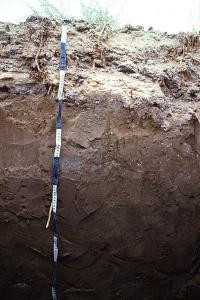Reference soil China 14: Solonchak
Solonchaks occur where saline groundwater comes near to the surface, or where through evapo(transpi)ration salts from the soil water accumulate in the soil, e.g. in desert regions
Characteristics
Soils having a salic horizon (horizon with accumulation of salts more soluble than gypsum) within 50 cm of the soil surface. They have no diagnostic horizons other than a histic, mollic, ochric, takyric, yermic, calcic, cambic, duric, gypsic or vertic horizon.
Reference soil CN014: Solonchak
Deep, imperfectly drained, saline brown sandy loam derived from colluvio-alluvial deposits, with a thick, hard, dirty white cristallized salt pan in the topsoil. The subsoil shows few to common white salt spots. Soil reaction is alkaline and the electrical conductivity is high. SURFACE CHARACTERISTICS: thin crust with "fluffy, crispy" crumby structure / VEGETATION: 10-20% covered by salt resistant herb and reed vegetation, consisting mainly of Alhagi and Phragmites.
|
WRB 2006: |
WRB 1998: |
||||||||
|
|
||||||||
|
|
|
FAO-UNESCO-ISRIC 1988: |
FAO-UNESCO 1974: |
||||||||||||
|
|
||||||||||||
|
|
Other classification
|
Classification (other) |
Salipanic brown desert soil; Panic Sali-Orthic Aridosol |
Xinjiang Autonomous Region, Turpan
